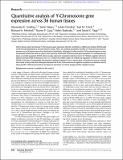Notice
This is not the latest version of this item. The latest version can be found at:https://dspace.mit.edu/handle/1721.1/136020.2
Quantitative analysis of Y-Chromosome gene expression across 36 human tissues
Author(s)
Godfrey, Alexander K; Naqvi, Sahin; Chmátal, Lukáš; Chick, Joel M; Mitchell, Richard N; Gygi, Steven P; Skaletsky, Helen; Page, David C; ... Show more Show less
DownloadPublished version (3.326Mb)
Publisher with Creative Commons License
Publisher with Creative Commons License
Creative Commons Attribution
Terms of use
Metadata
Show full item recordAbstract
© 2020 Godfrey et al. Little is known about how human Y-Chromosome gene expression directly contributes to differences between XX (female) and XY (male) individuals in nonreproductive tissues. Here, we analyzed quantitative profiles of Y-Chromosome gene expression across 36 human tissues from hundreds of individuals. Although it is often said that Y-Chromosome genes are lowly expressed outside the testis, we report many instances of elevated Y-Chromosome gene expression in a nonreproductive tissue. A notable example is EIF1AY, which encodes eukaryotic translation initiation factor 1A Y-linked, together with its Xlinked homolog EIF1AX. Evolutionary loss of a Y-linked microRNA target site enabled up-regulation of EIF1AY, but not of EIF1AX, in the heart. Consequently, this essential translation initiation factor is nearly twice as abundant in male as in female heart tissue at the protein level. Divergence between the X and Y Chromosomes in regulatory sequence can therefore lead to tissue-specific Y-Chromosome-driven sex biases in expression of critical, dosage-sensitive regulatory genes.
Date issued
2020Journal
Genome Research
Publisher
Cold Spring Harbor Laboratory